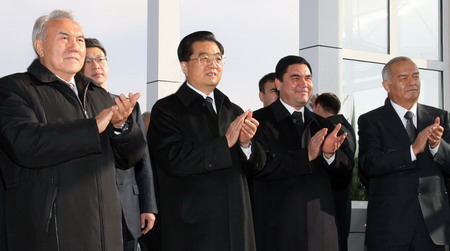
Strategic Implications of the Central Asia-China Gas Pipeline
Publication: Eurasia Daily Monitor Volume: 6 Issue: 233
By:

The breakthrough on the Central Asia-China gas pipeline (EDM, December 15), as part of Turkmenistan’s policy of gas export diversification, undermines Russia’s position not only in the European gas trade (EDM, December 16), but also on two Asian fronts. These are the negotiations on future Russian imports of Turkmen gas (in scaled-down volumes) and on possible Russian gas exports from eastern Siberia to China.
The Kremlin had offered in 2008 to pay European netback prices for Turkmen and other Central Asian gas, starting in 2009 at more than $300 per one thousand cubic meters. This offer doubled at one stroke the Russian purchase price for Central Asian gas (and quadrupled it from the 2005 level), erasing Gazprom’s windfall profits from the re-sale or swapping of Turkmen gas in Europe in previous years. Moscow was also launching an ambitious program to expand the capacity of gas pipelines from Central Asia to Russia, so as to increase Russian imports far beyond the then-prevailing level of 70 billion to 80 billion cubic meters (bcm) annually, which included 45 to 50 bcm from Turkmenistan. Anticipating a gas shortfall soon in Russia itself, Gazprom tried to maximize its intake of Turkmen gas to help meet Russia’s supply commitments. Moscow’s leverage was already weakening at that juncture thanks to the rapid advance of the Turkmenistan-China pipeline project.
The economic-financial crisis changed Moscow’s plans in spring 2009. With demand and prices declining for Russian gas in Europe, Moscow pressed to reduce either the volume of imported Turkmen gas or the purchase price for it. When Ashgabat resisted, Moscow halted the gas flow unilaterally and without the necessary advance notice on April 8-9, resulting in a blast on the over-pressurized Turkmen export pipeline. The line has been repaired since then, but the gas flow to Russia has not resumed until now.
Turkmenistan’s revenue losses from Russia cannot immediately or fully be compensated by revenue gained from China after the pipeline’s opening. Nevertheless, Turkmenistan’s bold diversification of gas exports to China and Iran –as well as possible export westward from Turkmenistan’s Caspian offshore– are steadily reducing Moscow’s leverage on Ashgabat. Based on its experience, Ashgabat takes the position that Russia does not offer security of demand even in the short term, whereas China’s voracious requirements promise fairly reliable, long-term security of demand for Turkmen gas (Xinhua, December 11–15).
Moscow and Ashgabat are currently negotiating arduously over the price, timetable, and other conditions for resuming Turkmen gas deliveries to Russia. The Kremlin and the Russian government are handling these negotiations directly, rather than through Gazprom. Deputy Prime Minister Igor Sechin (responsible for the energy sector) held talks with Turkmen President Gurbanguly Berdimuhamedov in Ashgabat on December 15 –the day after the opening of the Turkmenistan-China pipeline– and Russian President Dmitry Medvedev followed up with Berdimuhamedov by telephone to arrange a year-end visit to Ashgabat. The official communiqués about the presidents’ telephone conversation hardly mentioned gas, focusing instead on the reopening of a “Pushkin” school in Ashgabat –a clear indication of persisting differences over the gas trade (Interfax, Turkmen government website, December 15, 16).
Moscow evidently wants to retain access to Turkmen gas, but can hardly predict the timeframe of its post-crisis recovery and corresponding gas demand recovery in Europe. That period may well coincide with the Turkmenistan-China pipeline attaining full capacity and providing Ashgabat with a fully-fledged alternative option. Thanks largely to this factor, Russian
leverage on Turkmenistan should from now on recede with every passing year. Further strengthening Ashgabat’s hand, the new export pipeline to Iran is opening during this month, with a capacity of 6 bcm annually in the first stage and another 6 bcm in a follow-up stage. This line is being supplied from Turkmenistan’s Dauletabad field, dedicated to Russia until now (Turkmen Television, December 11; Voice of the Islamic Republic of Iran [Mashhad], December 13).
The pipeline to China strengthens not only Ashgabat’s, but also Beijing’s hand in negotiations with Moscow. The Russian and Chinese governments are negotiating the pricing and transportation terms for possible gas exports from eastern Siberia to China. The Russian side did not have to compete against another supplier until now. From now on, however, Russian gas production from newly commissioned eastern Siberian fields would have to compete with Turkmen gas over the sale price of gas to China. This emergent competition will undoubtedly overshadow the Russo-Chinese negotiations, which are scheduled to resume in 2010, on future terms for sale and purchase of gas.
European and US policies –insofar as they operate– have incurred a temporary setback with Chinese (and even Iranian) breakthroughs in Turkmenistan. This situation curtails the availability of Turkmen gas in the near-to-medium term for the Nabucco project and other components of the Southern Corridor to Europe. Any massive Turkmen deliveries into the planned corridor must await the development of the vast, untapped gas reserves onshore, which Ashgabat will likely apportion to various players.
China seems positioned ahead of all others at the supergiant South Yolotan-Osman fields, thanks to Beijing’s credit line for exploration and development there. In Turkmenistan’s Caspian offshore and older onshore fields, however, supplies should be unproblematic for Nabucco’s second phase, if a pipeline link takes shape organically between the outward tips of the Turkmen and Azerbaijani offshore infrastructure.




